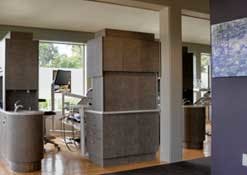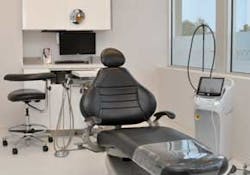Successfully building, upgrading, or expanding your dental practice requires a good deal of advance planning and careful thought to generate a realistic and functional design. As you work to visualize and define your practice design, consider incorporating the five principles used by the Dental Office Design Competition (DODC) panel of judges when evaluating competition entrants.
Sponsored by Wells Fargo Practice Finance, Dental Economics, ADA Business Resources, and the American Dental Association, the annual Dental Office Design Competition recognizes dental practices in a variety of categories including Design of the Year — Solo Practice, Design of the Year — Group Practice, and Outstanding Achievement Awards for New Dentist Practice, Design Efficiency, and Specialty Practice. Reviewing the online library of these winning practices at wellsfargo.com/dodccan provide inspiration for your own project and insights into the design decisions that contributed to their vision and success.Following are the five design principles that help DODC judges differentiate among good — and winning — practice designs.
1.Meetsstatedobjectives
Before starting any practice design project, whether it’s a complete start-up or a small upgrade, it’s important to understand what your business objectives are for the project. Are you solving a functional problem, or expanding capabilities? Do you have a vision for your practice that you are seeking to execute in your design — for instance, more space to add patients, a higher level of technology, greater functionality, or an open, friendly environment? An effective practice design reflects your vision for your dental practice and supports the objectives outlined in your business plan. The key is to think through your design project carefully and fully understand why you are doing it. The better you understand your objectives, the better you will execute your plan.
2.Achieves functional balance
Functional balance means that your project incorporates the principles of architectural design, clinical function, technology integration, and ergonomic design — all within the scope of your budget. These elements work together to produce a balanced, functional, well-designed practice that expresses your personal vision while effectively meeting the needs of your patients.
To achieve functional balance in your design project, work with design professionals to ensure you have adequately addressed these four cornerstones of practice design. Try not to cut corners in this area as functional balance can drive office efficiencies, patient comfort, and employee satisfaction — all key contributors to your overall level of productivity.3.Utilizes an effective floor plan
The floor plan is another key component in increasing office efficiency and building an effective practice design. You want room to move and expand your capabilities, but not so much room that you’re wasting steps and time. You need a balance between efficient traffic flow and comfortable movement between work zones for both staff and patients, from public to private spaces.
To get the most from your floor plan, ensure it can support your strategy for practice growth and is effective for the long-term, with adequate space for adding equipment or accommodating an increase in patients.
4. Incorporates updated equipment
Staying current with technology is a critical way of staying competitive in today’s dental market. Using up-to-date technology not only improves the overall proficiency of your practice, but also communicates to your patients that they will receive the utmost in care from you.
The next 15 years will bring remarkable changes in dental technologies, so now is an excellent time to incorporate a digital platform into your practice. At the same time, not all technology improvements are digital. Updated equipment can include everything from the latest in digital radiology to ergonomic patient chairs that address not only the patient’s comfort, but the doctor’s and clinical team’s comfort as well. It has been shown that practices that embrace new technologies thrive regardless of the state of the economy, while those who resist the transition to new technology tend to struggle. Be an "embracer" and build at least a few new technologie into your practice design. It will help position your business for future success.Usually, one of the key motivators for a practice redesign or upgrade is the desire to create a more contemporary and attractive presentation. It is indeed important that your practice has general physical appeal to patients and presents professionally in order to instill confidence. As one of the DODC judges points out, new patients have no way of evaluating the quality of services you will provide, and will take into account other factors that are tangible and subject to evaluation. In this context, the physical environment can communicate the level of excellence of the practice, with professional, current practice designs helping to assure the patient’s confidence in the doctor’s abilities.
To get a head start in outlining your practice design project, contact your Business Development Manager at Wells Fargo Practice Finance to request a complimentary Project Planner — a step-by-step guide for expanding, remodeling, and upgrading your practice.
Then, once your practice start-up, redesign, or expansion is completed, consider entering it into the Dental Office Design Competition. If you follow these five principles, your practice could be a winner!
For an entry form and complete Competition rules, visit wellsfargo.com/dodc.
Sponsors donotparticipate intheDentalOfficeDesignCompetitionjudgingpanel anddonotparticipate intheCompetitionjudgingprocess inanyway.
Allison Farey, President of Wells Fargo Practice Finance, has more than 25 years of experience in dental practice lending. Wells Fargo Practice Finance specializes in helping dentists acquire, start and expand their practices with its customized financing and signature Practice Success Program.
RELATED:2012 Dental Office Design Competition winners announced
RELATED:Is your practice a winner?








